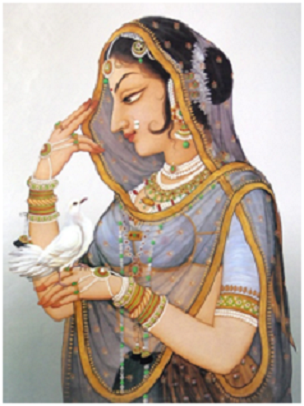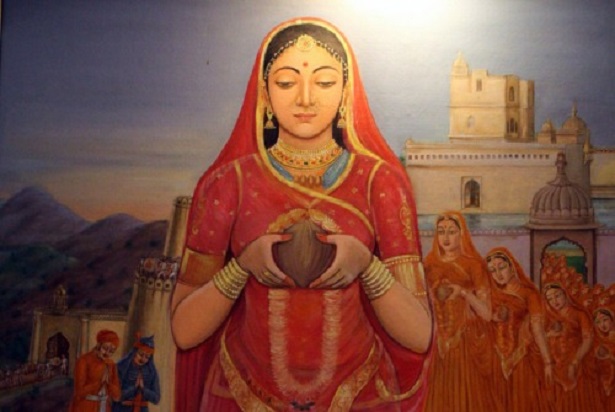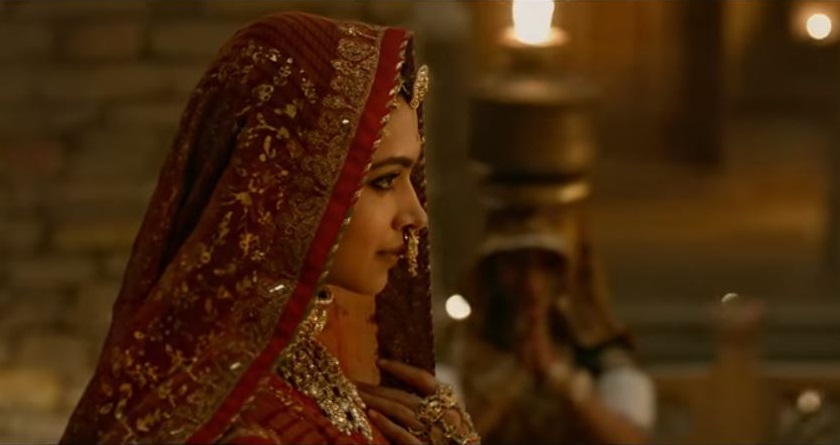Padmavati/ Maharani Padmini
| Line 2: | Line 2: | ||
[[File: Rani Padmavati @ Padmini2.jpg| Rani Padmavati @ Padmini |frame|500px]] | [[File: Rani Padmavati @ Padmini2.jpg| Rani Padmavati @ Padmini |frame|500px]] | ||
[[File: Rani Padmavati @ Padmini3.jpg| Rani Padmavati @ Padmini |frame|500px]] | [[File: Rani Padmavati @ Padmini3.jpg| Rani Padmavati @ Padmini |frame|500px]] | ||
| − | |||
| − | |||
| − | |||
| − | |||
| − | |||
| − | |||
| Line 43: | Line 37: | ||
It explains the ideals that animated Jayasi's noble e pic: “Throughout the work of the Musalman ascetic, there run veins of the broadest charity and of sym pathy with those higher spirits among his fellow countrymen who were searching in God's twilight for that truth of which some of them achieved a clear vision.“ In other words, the Sufi poet was using his creative licence to convey a philosophical message. And that creative licence is exactly what Bhansali is now being punished for. | It explains the ideals that animated Jayasi's noble e pic: “Throughout the work of the Musalman ascetic, there run veins of the broadest charity and of sym pathy with those higher spirits among his fellow countrymen who were searching in God's twilight for that truth of which some of them achieved a clear vision.“ In other words, the Sufi poet was using his creative licence to convey a philosophical message. And that creative licence is exactly what Bhansali is now being punished for. | ||
=Jayasi’s poem vis-à-vis history = | =Jayasi’s poem vis-à-vis history = | ||
| + | [[File: Rani Padmavati @ Padmini4b.jpg| Rani Padmavati @ Padmini <br/> From [https://www.youtube.com/watch?v=q6TUWY93whE Padmavati Real Story]. Though done in the traditional style, this seems to be a later painting.|frame|500px]] | ||
| + | |||
[https://swarajyamag.com/culture/rani-padmini-and-alauddin-khilji-separating-fact-from-fiction Ram Ohri, Rani Padmini And Alauddin Khilji: Separating Fact From Fiction, Jan 28, 2017, Swarajya Mag] | [https://swarajyamag.com/culture/rani-padmini-and-alauddin-khilji-separating-fact-from-fiction Ram Ohri, Rani Padmini And Alauddin Khilji: Separating Fact From Fiction, Jan 28, 2017, Swarajya Mag] | ||
| Line 64: | Line 60: | ||
According to Jayasi’s poem Padmavat, Rani Padmavati of Chittor was the wife of Raja Ratansen (a name invented by Jayasi with no reference in Mewar history) of Chittor during the reign of Allauddin Khilji. The correct name of Chittor's then ruler was Rawal Ratan Singh, the thirty-fourth descendant of Bappa Rawal. | According to Jayasi’s poem Padmavat, Rani Padmavati of Chittor was the wife of Raja Ratansen (a name invented by Jayasi with no reference in Mewar history) of Chittor during the reign of Allauddin Khilji. The correct name of Chittor's then ruler was Rawal Ratan Singh, the thirty-fourth descendant of Bappa Rawal. | ||
| + | |||
| + | [[File: Rani Padmavati @ Padmini5b.jpg| Rani Padmavati @ Padmini <br/> From [https://www.youtube.com/watch?v=q6TUWY93whE Padmavati Real Story] and [http://ramdevsinghinda.blogspot.in/2011/07/blog-post_3575.html Ramdev Singh Inda] <br/> Done in the European style, this seems to be a 20th century painting.|frame|500px]] | ||
''' What Jayasi’s poem says ''' | ''' What Jayasi’s poem says ''' | ||
| Line 78: | Line 76: | ||
Desperate to capture the beautiful Padmini, Khilji sent a word to Ratansen about him wanting to meet her. The Raja asked Padmini, who flatly refused. However, on being persuaded by her beleaguered husband, Rani Padmini agreed to let Khilji see her in the mirror. | Desperate to capture the beautiful Padmini, Khilji sent a word to Ratansen about him wanting to meet her. The Raja asked Padmini, who flatly refused. However, on being persuaded by her beleaguered husband, Rani Padmini agreed to let Khilji see her in the mirror. | ||
| + | |||
| + | [[File: Rani Padmavati @ Padmini6bb.jpg| Rani Padmavati @ Padmini <br/> From [https://www.youtube.com/watch?v=q6TUWY93whE Padmavati Real Story] and [http://ramdevsinghinda.blogspot.in/2011/07/blog-post_3575.html Ramdev Singh Inda] <br/> Done in the European style, this seems to be a 20th century painting.|frame|500px]] | ||
On being persuaded by her husband Rana Ratansen, Rani Padmini consented to allow Ala-ud-din to see her only in a mirror. On the word being sent to Ala-ud-din that Padmini would see him he came to the fort with his selected his best warriors who secretly made a careful examination of the fort's defences on their way to the Palace. ([http://www.chittorgarh.com/rani-padmini.asp Rani Padmini - A legendary beauty, Chittorgarh.com]) | On being persuaded by her husband Rana Ratansen, Rani Padmini consented to allow Ala-ud-din to see her only in a mirror. On the word being sent to Ala-ud-din that Padmini would see him he came to the fort with his selected his best warriors who secretly made a careful examination of the fort's defences on their way to the Palace. ([http://www.chittorgarh.com/rani-padmini.asp Rani Padmini - A legendary beauty, Chittorgarh.com]) | ||
| Line 86: | Line 86: | ||
The Rajput generals , led by two gutsy warriors, Gora and Badal, who were related to Padmini, decided to beat the Sultan at his own game and sent back a word that Padmini would be given to Ala-ud-din the next morning. On the following day at the crack of dawn, one hundred and fifty palanquins (covered cases in which royal ladies were carried in medieveal times) left the fort and made their way towards Ala-ud-din's camps The palanquins stopped before the tent where king Ratansen was being held prisoner. . Seeing that the palanquins had come from Chittor; and thinking that they had brought along with them his queen, king Ratansen was mortified. But to his surprise from the palanquins came out, not his queen and her women servants but fully armed soldiers, who quickly freed ; Ratansen and galloped away towards Chittor on horses grabbed from Ala-ud-din's stables. ([http://www.chittorgarh.com/rani-padmini.asp Rani Padmini - A legendary beauty, Chittorgarh.com]) | The Rajput generals , led by two gutsy warriors, Gora and Badal, who were related to Padmini, decided to beat the Sultan at his own game and sent back a word that Padmini would be given to Ala-ud-din the next morning. On the following day at the crack of dawn, one hundred and fifty palanquins (covered cases in which royal ladies were carried in medieveal times) left the fort and made their way towards Ala-ud-din's camps The palanquins stopped before the tent where king Ratansen was being held prisoner. . Seeing that the palanquins had come from Chittor; and thinking that they had brought along with them his queen, king Ratansen was mortified. But to his surprise from the palanquins came out, not his queen and her women servants but fully armed soldiers, who quickly freed ; Ratansen and galloped away towards Chittor on horses grabbed from Ala-ud-din's stables. ([http://www.chittorgarh.com/rani-padmini.asp Rani Padmini - A legendary beauty, Chittorgarh.com]) | ||
| + | |||
| + | [[File: Rani Padmavati @ Padmini and her brave female freinds prepare for their jauhar.jpg| Rani Padmavati @ Padmini and her brave friends prepare for their martyrdom (jauhar)|frame|500px]] | ||
On the following day at the crack of dawn, one hundred and fifity palaquins (covered cases in which royal ladies were carried in medieveal times) left the fort and made their way towards Ala-ud-din's camps The palanquins stopped before the tent where king Ratansen was being held prisoner. . Seeing that the palanquins had come from Chittor; and thinking that they had brought along with them his queen, king Ratansen was mortified. But to his surprise from the palanquins came out, not his queen and her women servants but fully armed soldiers, who quickly freed ; Ratansen and galloped away towards Chittor on horses grabbed from Ala-ud-din's stables. ([http://www.chittorgarh.com/rani-padmini.asp Rani Padmini - A legendary beauty, Chittorgarh.com]) | On the following day at the crack of dawn, one hundred and fifity palaquins (covered cases in which royal ladies were carried in medieveal times) left the fort and made their way towards Ala-ud-din's camps The palanquins stopped before the tent where king Ratansen was being held prisoner. . Seeing that the palanquins had come from Chittor; and thinking that they had brought along with them his queen, king Ratansen was mortified. But to his surprise from the palanquins came out, not his queen and her women servants but fully armed soldiers, who quickly freed ; Ratansen and galloped away towards Chittor on horses grabbed from Ala-ud-din's stables. ([http://www.chittorgarh.com/rani-padmini.asp Rani Padmini - A legendary beauty, Chittorgarh.com]) | ||
| Line 96: | Line 98: | ||
These women who committed Jawhar had to perish but their memory has been kept alive till today by bards and songs which glorify their act which was right in those days and circumstances. Thus a halo of honour is given to their supreme sacrifice. ([http://www.chittorgarh.com/rani-padmini.asp Rani Padmini - A legendary beauty, Chittorgarh.com]) | These women who committed Jawhar had to perish but their memory has been kept alive till today by bards and songs which glorify their act which was right in those days and circumstances. Thus a halo of honour is given to their supreme sacrifice. ([http://www.chittorgarh.com/rani-padmini.asp Rani Padmini - A legendary beauty, Chittorgarh.com]) | ||
| + | |||
| + | [[File: Rani Padmavati @ Padmini commits sati jauhar.jpg| Rani Padmavati @ Padmini commits sati jauhar <br/> This is a genuine, pre-modern miniature painting. As in a comic book, the story is depicted in the four horizontal panels of the page. Within each panel the story proceeds through individual frames. The jauhar (sati) is in Panel 3, centre. The battle is in the bottom panel.|frame|500px]] | ||
When author Ram Ohri visited Chittorgarh Fort in 2008 and asked the guide about the veracity of the mirror story, he said locals did not believe in it. | When author Ram Ohri visited Chittorgarh Fort in 2008 and asked the guide about the veracity of the mirror story, he said locals did not believe in it. | ||
| Line 118: | Line 122: | ||
3) Jayasi wrote this poem almost 237 years after Khilji's attack on Chittor. The literature of that era is full of highly imaginative narratives, and poets were known to gleefully use metaphors, alliterations and imaginary personifications. There is also a reference in Padmavat to a sorcerer called Raghav Chetan, who is believed to have been personified as a parrot. | 3) Jayasi wrote this poem almost 237 years after Khilji's attack on Chittor. The literature of that era is full of highly imaginative narratives, and poets were known to gleefully use metaphors, alliterations and imaginary personifications. There is also a reference in Padmavat to a sorcerer called Raghav Chetan, who is believed to have been personified as a parrot. | ||
| + | |||
| + | [[File: The Burning of the Rajput women during the siege of Chitorb.jpg| The Burning of the Rajput women during the siege of Chitor <br/> This page from the '' Akbarnama, '' painted between 1590-1595, shows the 'jauhar' of Rajput women after the Chittor fortress fell ''' in 1568. ''' |frame|500px]] | ||
''' Contradictions in Jayasi's poem ''' | ''' Contradictions in Jayasi's poem ''' | ||
| Line 133: | Line 139: | ||
Having questioned the motive for Khilji's invasion of Chittor, "it should be remembered that Khilji's lust for a Hindu queen is proved by the known instances of Queen Kamala Devi of Gujarat and the daughter of King Ramachandra of Devagiri. The story of Padmini should not be totally rejected as a myth. But it is impossible, at the present state of knowledge, to regard it definitely as a historical fact". | Having questioned the motive for Khilji's invasion of Chittor, "it should be remembered that Khilji's lust for a Hindu queen is proved by the known instances of Queen Kamala Devi of Gujarat and the daughter of King Ramachandra of Devagiri. The story of Padmini should not be totally rejected as a myth. But it is impossible, at the present state of knowledge, to regard it definitely as a historical fact". | ||
| + | [[File: Deepika Padukone as Rani_Padmavati_@_Padmini.jpg| Deepika Padukone as Rani Padmini in Sanjay Leela Bhansali’s interpretation of ''Padmavati '' (2017)|frame|500px]] | ||
''' References ''' | ''' References ''' | ||
Revision as of 09:25, 9 October 2017
This is a collection of articles archived for the excellence of their content. |
Contents |
Fact, fiction, epic poem, cinema
Sufi poet Jayasi made up the story that later got legend status, so Bhansali can't be threatened for taking creative license with the tale, say historians
Sanjay Leela Bhansali's upcoming film, Padmavati, is a story about a story. It is based on a 16th century literary saga by Sufi poet Malik Muhammad Jayasi, a romantic fiction about Delhi sultan Alauddin Khilji's sack of Chittor which itself had occurred over 200 years earlier, in 1303. In Jayasi's allegorical poem, a Rajput queen of Chittor chooses to immolate herself rather than submit to the sultan.
The myth, written in Avadhi in 1540, 30 years before Tulsidas began his Ramcharitmanas, has ended up being taken literally as history . It created, out of whole cloth, the legend of Padmini or Padmavati, the Ceylonese princess turned loyal queen --there is not a shred of historical evidence that she existed.And because of the popularity of the epic, the actual Alauddin Khilji, destroyer of the Mongols and one of India's most able administrators, is only remembered as a thwarted lover-boy , whose obsession and lust for another man's wife leads him to destroy a kingdom. The legend has been passed down as popular history for years and used to demonise Islamic empires. And now, custodians of that made-up `history' have used it to attack another cultural work -storming the sets of Bhansali's forthcoming period drama Padmavati, at Jaipur's Jaigarh fort.
Vigilantes of the Karni Sena, self-appointed defenders of Rajput honour, allegedly slapped and intimidated the director into changing some material. Narayan Divrala, the district president of Karni Sena, was quoted as having said, “We have learnt that the filmmakers are portraying the film as a love story between Alauddin Khilji and Padmini, which is a blatant distortion of history .“
Bhansali's film unit was forced to leave Jaipur, and the fracas has led to predictable battles on social media, between those who condemned the bullying and those who applauded their action. Some Twitter warriors even claimed that Bhansali was funded by Pakistan's ISI to make a “profane and offensive“ movie to hurt Hindus and ridicule their history .
But what was the Delhi-Chittor conflict about? “ A campaign of conquest has multiple historical causes, which may or may not include the personal preferences of a ruler.Chittorgarh was coveted by the Delhi sultans for strategic and com mercial reasons. With the passage of time, events became imbued with cultural meanings, which have more to do with politics and less with history ,“ says Delhi University historian Anirudh Deshpande.
Did Jayasi himself claim to be chronicling history? According to the Imperial Gazetter of India, 1909, “in the final verses of his work, the poet explains that it is all an allegory . By Chittor he means the body of man; by Ratan Singh, the soul; by the parrot, the guru or spiritual protector; by Padmavati, wisdom; by Alauddin, delusion, and so on.“
It explains the ideals that animated Jayasi's noble e pic: “Throughout the work of the Musalman ascetic, there run veins of the broadest charity and of sym pathy with those higher spirits among his fellow countrymen who were searching in God's twilight for that truth of which some of them achieved a clear vision.“ In other words, the Sufi poet was using his creative licence to convey a philosophical message. And that creative licence is exactly what Bhansali is now being punished for.
Jayasi’s poem vis-à-vis history

From Padmavati Real Story. Though done in the traditional style, this seems to be a later painting.
Ram Ohri, Rani Padmini And Alauddin Khilji: Separating Fact From Fiction, Jan 28, 2017, Swarajya Mag
Interspersed with extracts from Rani Padmini - A legendary beauty, Chittorgarh.com
Rani Padmini And Alauddin Khilji: Separating Fact From Fiction
SNAPSHOT
Malik Muhammad Jayasi’s poem Padmavat, does not have a historical basis.
Rani Padmini was the queen of Chittorgarh, and Alauddin Khilji, the ruler of Delhi.
The popular story says that when Khilji attacked Chittor, he fell for Padmini on seeing her reflection in the mirror. This story was woven by a well-known Indian poet, Malik Muhammad Jayasi, in 1540 AD, and finds echo in Jawaharlal Nehru's Discovery of India as well.
Jayasi’s poem about Padmini and Khilji, however, is not accurate. Historians have, in fact, come up with possible scenarios for what could have actually happened.
According to Jayasi’s poem Padmavat, Rani Padmavati of Chittor was the wife of Raja Ratansen (a name invented by Jayasi with no reference in Mewar history) of Chittor during the reign of Allauddin Khilji. The correct name of Chittor's then ruler was Rawal Ratan Singh, the thirty-fourth descendant of Bappa Rawal.
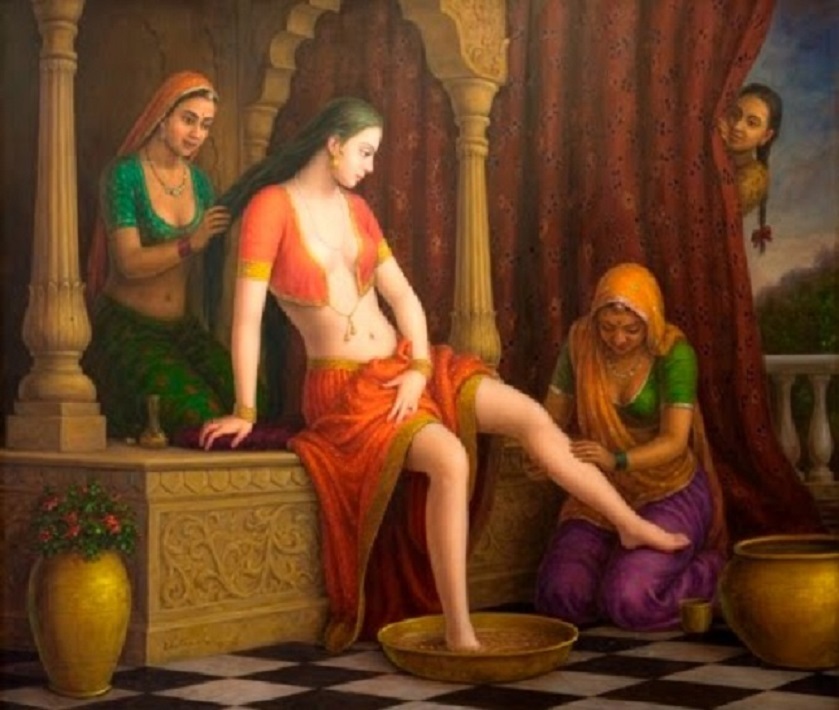
From Padmavati Real Story and Ramdev Singh Inda
Done in the European style, this seems to be a 20th century painting.
What Jayasi’s poem says
In the 12th and 13th centuries, the Sultanate of Delhi - the kingdom set up by the invaders was nevertheless growing in power. The Sultans made repeated attack on Mewad on one pretext or the other. Here we may recollect the story of Rani Padmani who was the pretext for Allah-ud-din Khilji's attack on Chittod. In those days Chittod was under the Rule of King Ratansen, a brave and noble warrior-king. Apart, from being a loving husband and a just ruler, Ratansen was also a patron of the arts. In his court were many talented People one of whom was a musician named Raghav Chetan. But unknown to anybody, Raghav Chetan was also a sorcerer. He used his evil talents to run down his rivals and unfortunately for him was caught red-handed in his dirty act of arousing evil spirits. (Rani Padmini - A legendary beauty, Chittorgarh.com)
On hearing this King Ratansen was furious and he banished Raghav Chetan from his kingdom after blackening his face with face and making him ride a donkey. This harsh Punishment earned king Ratansen an uncompromising enemy. Sulking after his humiliation, Raghav Chetan made his way towards Delhi with -the aim of trying to incite the Sultan of Delhi Ala-ud-din Khilji to attack Chittor. (Rani Padmini - A legendary beauty, Chittorgarh.com)
On approaching Delhi, Raghav Chetan settled down in one of the forests nearby Delhi which the Sultan used to frequent for hunting deer. One day on hearing the Sultan's hunt party entering the forest, Raghav-Chetan started playing a melodious tone on his flute. When the alluring notes of Raghav-Chetan flute reached the Sultan's party they were surprised as to who could be playing a flute in such a masterly way in a forest. (Rani Padmini - A legendary beauty, Chittorgarh.com)
The Sultan despatched his soldiers to fetch the person and when Raghav-Chetan was brought before him, the Sultan Ala-ud-din Khilji asked him to come to his court at Delhi. The cunning Raghav-Chetan asked the king as to why he wants to have a ordinary musician like himself when there were many other beautiful objects to be had. Wondering what Raghav-Chetan meant, Ala-ud-din asked him to clarify. Upon being told of Rani Padmini's beauty, Ala-ud-din's lust was aroused and immediately on returning to his capital he gave orders to his army to march on Chittor. (Rani Padmini - A legendary beauty, Chittorgarh.com)
But to his dismay, on reaching Chittor, Allah-ud-din found the fort to be heavily defended. Desperate to have a look at the legendary beauty of Padmini, he sent word to King Ratansen that he looked upon Padmini as his sister and wanted to meet her. On hearing this, the unsuspecting Ratansen asked Padmini to see the 'brother'. But Padmini was more wordly-wise and she refused to meet the lustful Sultan personally. (Rani Padmini - A legendary beauty, Chittorgarh.com)
Desperate to capture the beautiful Padmini, Khilji sent a word to Ratansen about him wanting to meet her. The Raja asked Padmini, who flatly refused. However, on being persuaded by her beleaguered husband, Rani Padmini agreed to let Khilji see her in the mirror.
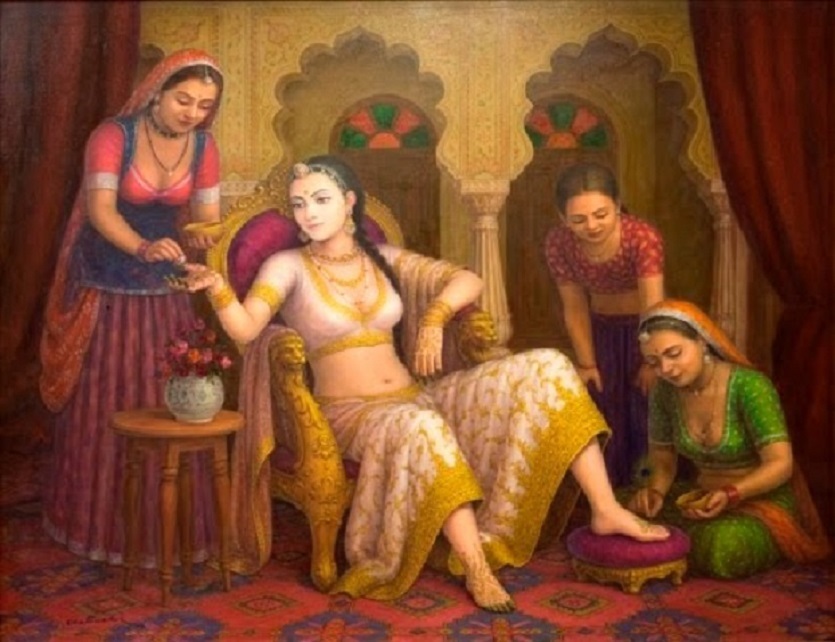
From Padmavati Real Story and Ramdev Singh Inda
Done in the European style, this seems to be a 20th century painting.
On being persuaded by her husband Rana Ratansen, Rani Padmini consented to allow Ala-ud-din to see her only in a mirror. On the word being sent to Ala-ud-din that Padmini would see him he came to the fort with his selected his best warriors who secretly made a careful examination of the fort's defences on their way to the Palace. (Rani Padmini - A legendary beauty, Chittorgarh.com)
Khilji had entered the fort with a group of select warriors who had observed the fort's defences on their way to the palace. On seeing Padmini in the mirror, Khilji decided that she must be his.
On seeing Padmini, in the mirror, the lustful 'brother', Allah-ud-din Khilji decided that he should secure Padmini for himself. While returning to his camp, Allah-ud-din was accompanied for some way by King Ratansen. Taking this opportunity, the wily Sultan deceitfully kidnapped Ratansen and took him as a prisoner into his camp and demanded that Padmini come and surrender herself before Ala-ud-din Khilji, if she wanted her husband King Ratansen alive again. (Rani Padmini - A legendary beauty, Chittorgarh.com)
The Rajput generals , led by two gutsy warriors, Gora and Badal, who were related to Padmini, decided to beat the Sultan at his own game and sent back a word that Padmini would be given to Ala-ud-din the next morning. On the following day at the crack of dawn, one hundred and fifty palanquins (covered cases in which royal ladies were carried in medieveal times) left the fort and made their way towards Ala-ud-din's camps The palanquins stopped before the tent where king Ratansen was being held prisoner. . Seeing that the palanquins had come from Chittor; and thinking that they had brought along with them his queen, king Ratansen was mortified. But to his surprise from the palanquins came out, not his queen and her women servants but fully armed soldiers, who quickly freed ; Ratansen and galloped away towards Chittor on horses grabbed from Ala-ud-din's stables. (Rani Padmini - A legendary beauty, Chittorgarh.com)
On the following day at the crack of dawn, one hundred and fifity palaquins (covered cases in which royal ladies were carried in medieveal times) left the fort and made their way towards Ala-ud-din's camps The palanquins stopped before the tent where king Ratansen was being held prisoner. . Seeing that the palanquins had come from Chittor; and thinking that they had brought along with them his queen, king Ratansen was mortified. But to his surprise from the palanquins came out, not his queen and her women servants but fully armed soldiers, who quickly freed ; Ratansen and galloped away towards Chittor on horses grabbed from Ala-ud-din's stables. (Rani Padmini - A legendary beauty, Chittorgarh.com)
On hearing that his designs had been frustrated, the lustful Sultan was furious and ordered his army to storm Chittor. But hard as they tried the Sultans army could not break into the fort. Then Ala-ud-din decided to lay seige to the fort. The seige was a long drawn one and gradually supplied within the fort were depleted. Finally King Ratnasen gave orders that the Rajputs would open the gates and fight to finish with the besieging troops. On hearing of this decision, Padmini decided that with their men-folk going into the unequal struggle with the Sultan's army in which they were sure to perish, the women of Chittor had either to commit suicides or face dishonour at the hands of the victorious enemy. (Rani Padmini - A legendary beauty, Chittorgarh.com)
When Khilji entered the fort, all that he found were ashes of these brave women. Their sacrifice has been kept alive by Bards in their songs, where they praise women who preferred supreme sacrifice to dishonour.
The choice was in favour of suicide through Jauhar. A huge pyre was lit and followed by their queen, all the women of Chittor jumped into the flames and deceived the lustful enemy waiting outside. With their womenfolk dead, the men of Chittor had nothing to live for. Their charged out of the fort and fought on furiously with the vastly Powerful array of the Sultan, till all of them perished. After this phyrrhic victory the Sultan's troops entered the fort only to be confronted with ashes and burnt bones of the women whose honour they were going to violate to satisfy their lust. (Rani Padmini - A legendary beauty, Chittorgarh.com)
These women who committed Jawhar had to perish but their memory has been kept alive till today by bards and songs which glorify their act which was right in those days and circumstances. Thus a halo of honour is given to their supreme sacrifice. (Rani Padmini - A legendary beauty, Chittorgarh.com)
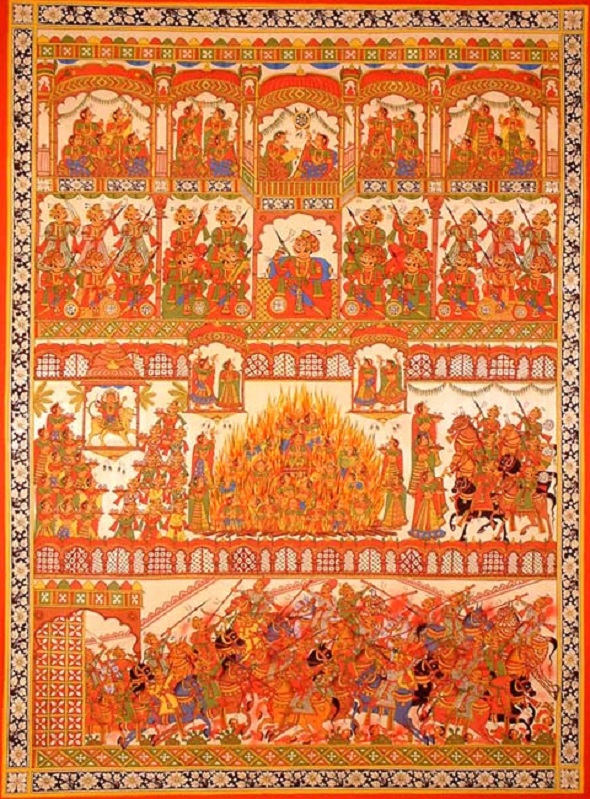
This is a genuine, pre-modern miniature painting. As in a comic book, the story is depicted in the four horizontal panels of the page. Within each panel the story proceeds through individual frames. The jauhar (sati) is in Panel 3, centre. The battle is in the bottom panel.
When author Ram Ohri visited Chittorgarh Fort in 2008 and asked the guide about the veracity of the mirror story, he said locals did not believe in it.
Having learnt what Jayasi's poem says, let us now read what the Bhartiya Vidya Bhavan's book on Indian History says.
Bhartiya Vidya Bhavan's history
In January 1303, Khilji set out on his memorable campaign for the conquest of Chittor. He received strong resistance from the Rajputs under Rana Ratan Singh. The Rajputs offered heroic resistance for about seven months and then, after the women had perished in the flames of jauhar, the fort surrendered on August 26, 1303.
Whilst later writers like Abu-l Fazl, Haji-ud-Dabir (note these two authors use Padmini not as a name, but as a woman possessing special attributes) have accepted the story that the sole reason for invasion of Chittor was Khilji’s desire to get possession of Padmini, many modern writers are inclined to reject it altogether. They point out that the episode of Padmini was first mentioned by Malik Jayasi in 1540 A.D. in his poem Padmavat, which is a romantic tale rather than historical work. Further, the later day writers who reproduced the story with varying details, flourished long after the event, but their versions differed from one another on essential points.
Yarn 2 by Jayasi
In Padmavat, Jayasi wrote that Padmini was the daughter of Raja Gandharva Sen of Sri Lanka. The Lanka story has many contradictions.
1) The name Raja Gandharva Sen is nowhere found in Sinhalese history. The then Buddhist rulers of Lanka had contacts mainly with the Pandya kings of Tamil Nadu and none with Rajputana. The names of Lanka rulers at the time were Vijayabahu III (1220-24), Bhuvanaikabahu I (1281-83), Interregnum (1283-1302) and Vijayabahu V (1325-26 to 1344-45).
Instead, there is a strong possibility that Padmini was a princess of Jaisalmer or of Sinhala, a village near Sojat in Pali district of Rajasthan. In the history of Rajasthan, there are many references which indicate that Rani Padmini was the eleventh wife of Rawal Ratan Singh among his fifteen wives, as polygamy was prevalent among Rajput rulers then. There is, however, no confirmation of her father being Rana Salsi Tanwar as written in the book The Kingdom of Mewar by Irmgard Meininger, a German author.
2) In Padmavat, there is a reference to a parrot who flew all the way from Sri Lanka to Chittor as a messenger to inform Raja Ratansen, or Rawal Ratan Singh, about the beauty of Padmini, daughter of the Sinhala ruler Gandharvasen, making Ratansen travel all the way to the Sinhala kingdom to win the hand of Padmini. This narrative lacks credibility since Lanka never had a king by that name.
3) Jayasi wrote this poem almost 237 years after Khilji's attack on Chittor. The literature of that era is full of highly imaginative narratives, and poets were known to gleefully use metaphors, alliterations and imaginary personifications. There is also a reference in Padmavat to a sorcerer called Raghav Chetan, who is believed to have been personified as a parrot.
Contradictions in Jayasi's poem
Amir Khusro, the court poet of Khilji, who accompanied him during the Chittor attack, did not write about Padmini, nor did he allude any episode to her in his book Twarikh-e-Allai. To be fair, it is possible that Khusro might not have wanted to further spoil the image of Khilji. So he ignored the reference to Padmini. "According to Prof Habib, there is a covert allusion to Padmini episode by Khusro in his Khazain-ul-Fatuh, where he mentions the Queen of Sheba."
Equally important is the fact that Col James Tod did not refer to Khilji's desire to capture the beautiful Padmini in his book The Annals and Antiquities of Rajasthan.
There are many instances in history when court poets and writers have followed the instructions of the ruling kings, and wrote histories accordingly. For instance, the book Ain-i-Akbari by Abul Fazal, where he was instructed not to write about Mehrunissa's -- later known as Nur Jahan, wife of Mughal King Jahangir -- first marriage with an Afghan Pathan. However, there is a mention of her in Tuzuk-e-Jahangari as his beloved, and how his father had cheated on him.
It would not be wrong to say that Jayasi's poem Padmavat is a figment of his poetic imagination. "It has also been argued that the invasion of Chittor was the natural expansionist policy of Khilji and no Padmini was need for his casus belli".
The story of Khilji watching Padmini’s reflection in a mirror, or in a well, as stated in Discovery of India by Pandit Nehru, could have been based on a latter-day interpolation by some local poets. It could also be a phoney myth popularised by some imaginative storytellers.
Having questioned the motive for Khilji's invasion of Chittor, "it should be remembered that Khilji's lust for a Hindu queen is proved by the known instances of Queen Kamala Devi of Gujarat and the daughter of King Ramachandra of Devagiri. The story of Padmini should not be totally rejected as a myth. But it is impossible, at the present state of knowledge, to regard it definitely as a historical fact".
References
1. Volume 6 of the History and Culture and Indian People, published by the Bhartiya Vidya Bhavan, p 23
2. Rani Padmini - a legendary beauty
3. The Indian Express, 28 January 2017, p 11
'Rani Padmavati never existed'
It is said that the story of Rani Padmavati, also known as Padmini, and Alauddin Khilji’s siege of King Rawal Ratan Singh’s Chittor took place in 1303. However, noted historian S Irfan Habib argues that Rani Padmavati was not a historical figure as there is record of her before 1540. According to him, the queen was a fictional figure created in the poem, ‘Padmavat’ written by Malik Mohd Jayasi in 1540.
The poem had famously traced the story of Padmini, Alauddin Khilji and Rawal Ratan Singh.
Habib took to Twitter to express his views, also finding similarities with the character Anarkali, shown in films like ‘Mughal-E-Azam’, who he also claims was not a historical character but a fictional one.
Habib pointed out that ‘Prof KS Lal and Prof Gauri Shankar Ojha, an expert on Rajasthan history find nothing before Padmini legend was created in 1540.’
See also
Of the various Indpaedia pages on Mewar, the pages
Mewar 08: Historical facts furnished by the bard Chand and
Mewar 09: Delicacy of the Rajputs
cover the 1300s.
However, may also like to see
Mewar 05: Alleged Persian extraction of the Ranas
Mewar 06: Samarsi, Mahmud's Invasion
Mewar 10: Succession of Kumbha
Mewar 11: Banishment of the Charans
Mewar 12: Accession of Rana Sanga
Mewar: Stability of Mewar State
